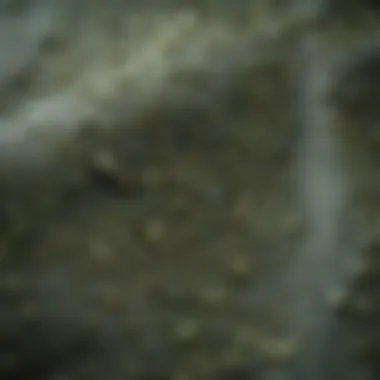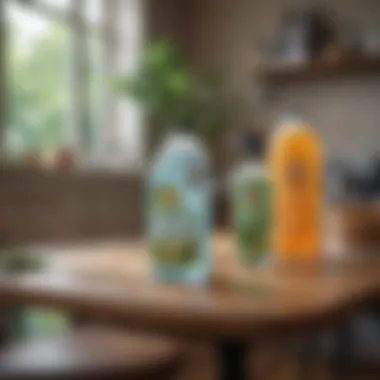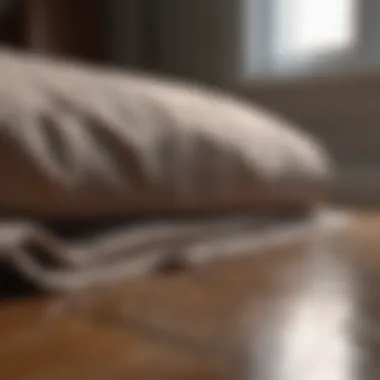Mastering Mildew Removal Techniques for Fabrics


Intro
Mildew poses a persistent challenge for fabric owners. Whether it grows in damp storage areas or infiltrates items like clothing and upholstery, understanding how to effectively address this issue is crucial. This article seeks to empower readers with a clear guide detailing the causes of mildew, effective cleaning methods, and preventive measures to extend the life of their fabric possessions.
Mildew thrives in moisture-rich environments. Therefore, knowledge of its growth conditions is paramount. This enables the selection of appropriate cleaning techniques and helps in choosing suitable fabrics that resist mildew accumulation. Through this examination, the discussion below will unveil essential strategies for mildew removal from various fabric types, ultimately supporting a healthier home environment.
Understanding Mildew on Fabric
Mildew on fabric can become a persistent issue in many households. Understanding mildew is essential for effective mildew removal. This knowledge is the first step in prevention and remediation. Mildew thrives in moisture-rich environments, often resulting in unpleasant odors and unsightly stains on fabrics. This often leads to the need for immediate action.
Identifying mildew early can save fabrics from irreversible damage. It can also prevent the spread of spores, which can affect other areas of the home. Knowledge about mildew and its environment allows homeowners to create better conditions. This helps keep their living spaces clean and pleasant.
What is Mildew?
Mildew is a type of fungus that typically appears in damp areas. It often forms as a thin film on surfaces. Mildew can be mistaken for mold, though it's less harmful. It usually appears as a white, gray, or powdery substance that can easily be brushed away if caught early. The main danger of mildew lies in its ability to compromise the integrity of fabric over time.
Causes of Mildew Growth
Multiple factors contribute to mildew growth on fabrics. The most significant are:
- Moisture: Fabrics that remain wet or retain moisture can foster mildew.
- Warmth: Mildew prefers warmer environments to grow.
- Poor ventilation: Lack of airflow promotes humidity, which is favorable for mildew.
- Organic materials: Natural fibers such as cotton and wool are more susceptible to mildew than synthetic fabrics.
Impact of Humidity on Fabric
Humidity plays a critical role in mildew formation. High levels of humidity create ideal conditions for mildew spores to settle and flourish. When humidity levels rise above 60%, it creates an environment conducive to mildew growth. Fabrics exposed to high humidity can absorb moisture, making them vulnerable. It is crucial to monitor indoor humidity levels to prevent mildew.
To mitigate the effects of humidity, it is advisable to utilize dehumidifiers or ensure proper ventilation in your home.
Understanding these elements is fundamental for addressing mildew issues effectively. By being aware of what mildew is, its causes, and the role of humidity, readers can take steps to protect their fabrics.
Identifying Affected Fabrics
Identifying affected fabrics is crucial in the process of mildew removal. Understanding which materials are prone to mildew growth allows one to take proactive steps in maintenance and cleaning. Not all fabrics are equal in their susceptibility to mildew; therefore, knowing the types can lead to targeted strategies for prevention and treatment. This section will delve into the specific fabrics that are at risk and the visible signs indicating mildew presence.
Types of Fabrics Susceptible to Mildew
Certain fabrics create an ideal environment for mildew to flourish. Here are the main types that are particularly vulnerable:
- Cotton: This is a natural fiber, highly absorbent which can easily retain moisture, making it a prime target for mildew.
- Linen: Similar to cotton, linen can accumulate dampness, especially in humid conditions, leading to mildew growth.
- Wool: Because of its protein structure, wool can attract mildew when exposed to moisture consistently.
- Silk: Although luxurious, silk absorbs moisture well and can develop mildew if not stored properly.
- Canvas: Commonly used in outdoor gear, canvas can easily trap moisture, especially when used in wet conditions without proper mayventilation.
Understanding the nature of these fabrics is essential for prevention. When these materials are exposed to high humidity or damp environments, they are more prone to develop mildew.
Signs of Mildew on Fabric
Being able to identify mildew early is essential to mitigate damage. Some common signs include:
- Discoloration: Fabric may develop dark spots or patches which appear grey or black. This is often one of the first visible signs of mildew.
- Odor: A musty or damp smell often accompanies mildew-affected fabrics, which can be a clear indication that something is wrong.
- Texture Changes: The fabric’s surface may begin to feel soggy or slimy instead of smooth and clean. This indicates moisture retention and potential mildew growth.
- Staining: Prolonged mildew growth can lead to permanent stains that may not come out with regular cleaning methods.


Regular inspections of fabric items can help catch mildew signs in the early stages.
Understanding how to identify affected fabrics not only aids in the immediate removal of mildew but also helps prevent further complications. By focusing on the kinds of materials that are susceptible and recognizing the signs of mildew, one can maintain their fabrics in better condition over time.
Preparation for Mildew Removal
Preparing for mildew removal is a critical step in the cleansing process. The right approach not only enhances the effectiveness of the removal methods but also protects the integrity of the fabric being treated. Understanding the tools and materials required will facilitate a smoother experience, ensuring that mildew doesn’t return after treatment. Additionally, it’s important to consider safety precautions to protect oneself from potential harm during the cleaning process.
Tools and Materials Needed
To successfully tackle mildew, certain tools and materials are essential. These include:
- Soft Brushes: Loosening the mold or mildew from fabric is often necessary. Soft brushes can do this without damaging the fibers.
- Baking Soda: This is a natural cleaner and deodorizer, effective in neutralizing odors.
- Distilled Vinegar: Known for its antimicrobial properties, vinegar can kill mildew spores.
- Hydrogen Peroxide: A powerful cleaning agent, it can effectively bleach and eliminate mildew.
- Clean Water: Always use clean water for rinsing, as it helps to remove excess cleaning agents.
- Protective Gloves: Protect hands from harsh substances in cleaning agents.
- Face Mask: To prevent inhalation of mold spores, especially in heavy infestations.
These items represent a starting point and can vary based on the extent of mildew contamination present. It’s wise to gather everything before beginning to ensure a thorough and diligence removing mildew.
Safety Precautions
Safety should never be overlooked while engaging in mildew removal. Here are some important precautions to consider:
- Work in a Ventilated Area: Good airflow is critical. If possible, take the fabric outdoors to avoid accumulating mold spores in your indoor environment.
- Wear Protective Gear: Using gloves and a mask can prevent skin irritation and respiratory issues.
- Test Cleaning Agents: Before applying any solution to a visible area, test it on a small hidden part of the fabric to ensure it doesn’t lead to discoloration.
- Keep Away from Open Flames: Some cleaning agents can be flammable, so ensure there are no open flames nearby when cleaning.
- Dispose Correctly: Securely dispose of any materials contaminated with mold or mildew. This helps prevent re-contamination and ensures a safer environment.
Taking these precautions can greatly reduce health risks and ensure more effective mildew treatment.
Preparation is not just about having the right tools; it is a holistic approach that encompasses safety, effectiveness, and care for the fabrics involved. By ensuring a sound preparation phase, one can significantly reduce the chances of mildew returning post-treatment.
Cleaning Methods for Mildew Removal
Cleaning methods play a crucial role in restoring the integrity of fabric affected by mildew. With various options available, it is essential to understand which techniques work best for specific situations. Effective cleaning methods can vary based on the type of fabric, extent of mildew growth, and the products utilized. The primary consideration is to remove mildew without causing further damage, and this necessitates a careful selection of cleaning materials and techniques. Adopting appropriate cleaning methods not only addresses the immediate issue but also contributes to long-term maintenance of the fabric.
Using Household Products
Household cleaning products can be a practical, inexpensive solution for combating mildew. Such products are often accessible and safe to use, making them ideal for various applications. Below are some effective household products:
Baking Soda
Baking soda is well-known for its versatility in cleaning. Its primary characteristic is its natural deodorizing property. This makes it a beneficial choice in the mildew removal process both for odor and visible stains. It is a mildly abrasive substance, which allows it to scrub away residue without harming the fabric.
The unique feature of baking soda is its ability to absorb moisture, which is crucial since mildew thrives in damp conditions. Its disadvantages are limited; however, it may require multiple applications for stubborn stains. Overall, baking soda is an effective and eco-friendly solution for mildew removal.
Vinegar
Vinegar is another common household item recognized for its cleaning prowess. Its key characteristic is its acidity, which can effectively kill mildew spores. This makes it a beneficial choice when dealing with affected fabrics. Unlike bleach, vinegar is less harsh and can be used on a wider variety of fabrics without causing discoloration.
The unique feature of vinegar is its ability to neutralize odors as well as its cleaning capabilities. One limitation of using vinegar is its strong scent, which can linger. Nevertheless, it remains a practical choice for mildew remediation, especially in combination with other methods.
Hydrogen Peroxide
Hydrogen peroxide is widely celebrated for its disinfecting properties. Its key characteristic is its strong oxidizing ability, allowing it to tackle mildew effectively. This makes it a popular choice for users looking for a thorough cleaning solution.


The unique feature of hydrogen peroxide is its efficacy in breaking down the cell structure of mildew, leading to effective removal. However, it may cause fading on certain colored fabrics, so a patch test is always advisable. Overall, hydrogen peroxide can be a powerful ally in the fight against mildew.
Commercial Cleaning Solutions
Commercial cleaning solutions are specifically formulated to combat mildew and are often highly effective. These products range from sprays to specialized fabric cleaners and typically contain strong antifungal agents that can provide rapid and thorough remediation. While they can be pricier than household alternatives, they may provide a quicker solution for larger infestations, especially in specialized fabrics. However, careful consideration of fabric types and manufacturer instructions is essential to avoid damage.
Washing Machine Techniques
Washing machine techniques can also be employed effectively for mildew removal. Adjusting washing parameters can significantly impact cleaning outcomes, and knowing how to utilize these settings is vital.
Temperature Settings
Temperature settings on a washing machine are crucial for mildew remediation. Hot water is often more effective at killing mold spores compared to cold water. Therefore, using warm or hot water settings is advisable when washing mildew-affected fabrics. However, this must be matched with the type of fabric being cleaned, as some materials may shrink or fade in high temperatures. The unique feature here is the flexibility of most modern machines to offer various temperature options.
Cycle Options
Selecting the right cycle option is just as important as temperature settings. Many washing machines provide cycles that cater to delicate fabrics or heavy-duty washing. The unique aspect of this consideration is the ability to ensure thorough cleaning without compromising fabric integrity. For heavily soiled items, a long wash cycle may be beneficial, while delicate fabrics require gentler cycles. Choosing the right cycle can maximize the effectiveness of mildew removal.
Effective cleaning methods not only remove mildew but also help prolong the life of your fabric.
Post-Cleansing Care
After removing mildew from fabric, effective post-cleansing care is crucial to prevent recurrence and ensure the longevity of the material. This stage focuses on drying techniques and preventive measures that help maintain fabric integrity and minimize fungal growth. Taking the right steps in this phase significantly enhances the success of mildew remediation.
Drying Techniques
Proper drying plays an essential role in eliminating any residual moisture that may support mildew regrowth. Depending on the type of fabric and the situation, two primary techniques can be employed: air drying and tumble drying.
Air Drying
Air drying is one of the most common methods of drying fabric after washing. This technique involves hanging the fabric in a well-ventilated area, allowing natural airflow to aid in drying. The key characteristic of air drying is its gentleness on the fabric. It is a popular choice for delicate materials that could be damaged by high heat.
The unique feature of air drying is its sustainability. Using ambient air rather than energy-intensive machines can be more environmentally friendly. However, this method requires time and optimal weather conditions, which can be a disadvantage in humid climates, prolonging the risk of mildew.
Tumble Drying
Tumble drying, on the other hand, uses a machine to dry the fabric rapidly. The advantage of this method is speed; fabric can be dried in a fraction of the time needed for air drying. The key characteristic of tumble drying is its efficiency in removing moisture.
However, caution is needed, as high heat settings can damage some fabrics. Tumble dryers also consume a considerable amount of energy, which may not be appealing for eco-conscious individuals. Therefore, understanding the fabric type is crucial to choosing this drying method.
Preventive Measures
Preventive measures form an essential part of post-cleansing care, ensuring that mildew does not return. Two effective strategies include proper storage practices and humidity control.
Storage Practices
Effective storage practices prevent mildew from establishing itself in the first place. This involves keeping fabrics in dry, clean environments. Air-tight containers can significantly limit the exposure to humidity and contaminants that promote mildew growth. The key characteristic here is creating a controlled environment.


Using silica gel packets or dehumidifiers in storage areas can further assist in maintaining the right conditions. However, it is essential to monitor these storage areas and ensure they do not trap moisture themselves, which could encourage mildew.
Humidity Control
Humidity control is another fundamental preventive measure. Maintaining the humidity levels in living spaces can greatly affect fabric health. The key characteristic of effective humidity control is the use of dehumidifiers or HVAC systems designed to regulate moisture levels.
High humidity can lead to mold and mildew growth, making this an invaluable choice for households, especially in humid regions. The unique feature of implementing humidity control measures is their comprehensive protection against a range of moisture-related issues. However, ongoing management is necessary, which may be seen as a burden for some.
By strategically addressing post-cleansing care through proper drying techniques and preventive measures, one can safeguard fabrics from mildew, enhancing their longevity and appearance.
Long-Term Fabric Maintenance
Long-term fabric maintenance is crucial when it comes to preventing mildew growth. Fabrics that are not properly cared for can create environments conducive to mildew development. This section emphasizes the significance of maintaining fabric to ensure its longevity and cleanliness. It encompasses two main elements: regular cleaning routines and the selection of mildew-resistant fabrics.
Maintaining fabrics not only enhances their appearance but also increases their lifespan. Regular upkeep can prevent issues that arise from mildew, which is often a consequence of neglect. In high-humidity settings, fabrics are particularly prone to mildew. Therefore, it is essential to integrate maintenance practices into your household routine.
Regular Cleaning Routines
Implementing regular cleaning routines is one of the most effective strategies for long-term fabric maintenance. It’s good to create a schedule tailored to the types of fabric and their specific cleaning requirements.
- Frequency: Different fabrics require different cleaning frequencies. For example, upholstery should be vacuumed weekly, while curtains can often be washed every few months.
- Pre-Treatment: Before washing, inspect your fabrics for mildew spots. Treat these areas promptly with appropriate cleaning agents.
- Proper Washing: Follow care labels and use suitable detergents. Consider using a mold or mildew prevention product in the wash cycle.
- Drying: Ensure that all washed fabrics are thoroughly dried. Even slightly damp fabric can promote mildew growth.
Choosing Mildew-Resistant Fabrics
When selecting fabrics, the choice of materials plays a significant role in mildew prevention. Opting for mildew-resistant fabrics can lead to significant benefits in the long run.
- Synthetic Fabrics: Fabrics such as polyester and nylon have naturally lower moisture absorption levels. This quality makes them less susceptible to mildew.
- Natural Resistance: Some natural fabrics, like treated cotton, can be designed to resist mildew. These treatments inhibit mold growth while still maintaining breathability.
- Application Considerations: When purchasing new fabrics, consider where they will be used. Fabrics for high-humidity areas, such as bathrooms or kitchens, should prioritize mildew resistance.
Incorporating mildew-resistant fabrics into your home can reduce the chances of future infestations, leading to cleaner, healthier living spaces.
In summation, prioritizing long-term fabric maintenance through regular cleaning routines and judicious fabric choice is vital. By actively pursuing these practices, individuals can significantly limit mildew development and keep their fabric items in optimal condition.
When to Seek Professional Help
Mildew infestations can range from manageable to severe. For many, the process of removing mildew from fabric is a DIY task. However, there are situations when professional services become necessary. Understanding when to seek help is crucial.
Professional cleaners have the expertise and the right equipment to tackle stubborn mildew. They can assess the extent of the damage and choose appropriate cleaning methods that may not be available to the average person. Moreover, they can treat the underlying causes of mildew growth, not just the visible signs. This comprehensive approach minimizes the risk of recurrence, which can be a common issue with poorly managed infestations.
Indications for Professional Services
Certain signs should alert you that a mildew problem may exceed your capacity to manage. These indicators include:
- Widespread Infestation: If the mildew covers a large area on the fabric, tackling it without specialized equipment may lead to further spread.
- Persistent Odor: An ongoing musty smell, even after cleaning attempts, suggests mildew has penetrated deeper than surface-level.
- Health Concerns: Anyone experiencing respiratory issues or allergies could be adversely affected by prolonged exposure to mildew. In such cases, seeking professional services is wise.
- Valuable Items: If the affected fabric holds significant value, like antiques or heirlooms, a professional can ensure that these items are treated with care.
- Complex Fabrics: Some fabrics, like silk or velvet, require delicate handling during cleaning. Professionals have the knowledge for proper care.
By considering these indicators, you can make informed decisions about whether to attempt removal yourself or to enlist professional help. Ultimately, prioritizing safety and effectiveness in dealing with mildew will protect not only your fabric but also your health and environment.
Environmental Considerations
Addressing mildew on fabric requires an understanding of environmental factors that contribute to its growth and removal. In an era where sustainability matters, ecologically friendly practices become crucial. Cleaning fabrics affected by mildew can involve substances that are harmful to both the environment and health. Thus, eco-friendly cleaning practices not only boost fabric longevity but also minimize environmental harm.
Utilizing natural cleaning agents has several benefits. First, most household products like vinegar, baking soda, and hydrogen peroxide are non-toxic. This reduces risks to human health and pets. Second, these substances are biodegradable. They break down naturally, causing less pollution and harm to water systems. Opting for eco-friendly methods also contributes to a broader trend of reducing chemical use in cleaning processes.
Moreover, embedding eco-friendliness in mildew removal aligns with global efforts towards sustainable living. By adopting responsible practices, individuals play a part in conserving resources. They limit chemical runoffs that often find their way into aquatic ecosystems, threatening fish and local flora.
Ultimately, the consideration of environmental factors in mildew removal from fabric is an investment in health and sustainability. It promotes healthier living spaces while also safeguarding our planet. Therefore, the approach to cleaning is not only a matter of aesthetics but a critical component of responsible stewardship.



